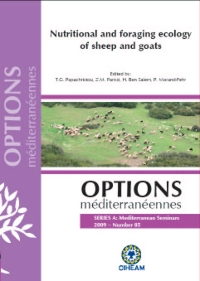| Article précédent | p. 111-116 | Article suivant |
Weed selection by sheep grazing dryland lucerne
Diet selection by sheep grazing dryland lucerne with a high proportion of weeds was assessed in two consecutive years (2005/2006). The study was performed on 2.66 ha of pasture divided in two homogeneous paddocks subjected to a stocking rate of either 10 or 20 sheep/paddock, and grazed for 17 days. Before and after each grazing trial, an inventory was conducted to assess the frequency and the phenological state of each plant species. The amount of biomass was determined pre- and post-grazing in each paddock and for each year, and the different species identified were separated by hand, dried and weighed to calculate their contribution to the total biomass. The plants that showed the higher selection score were Medicago sativa, Lolium rigidum, Eruca vesicaria (ssp. sativa) and Diplotaxis erucoides, regardless of the stocking rate or the year of study (P < 0.05), whereas Bromus rubens, Carduus bourgeanus and Onopordum acanthium were absolutely rejected. Other species were more consumed in the paddocks with a higher stocking rate, or in the year where the initial biomass was less abundant (2005). The interactions stocking rate × species and year × species were both non significant (P > 0.05). The n-alkanes concentration in the consumed fraction of each eaten plant was also analysed, and the values expressed as proportion of the total alkanes subjected to a stepwise discriminant analysis. n-Alkane profiles in the eaten fraction of the consumed species were different enough to allow their identification as components of the diet.
La sélection du régime a été étudiée en utilisant des ovins pâturant de la luzerne non irriguée avec une grande proportion de mauvaises herbes sur deux années consécutives (2005/2006). L'essai a été conduit sur un parcours de 2,66 ha divisé en deux parties égales supportant une charge de 10 et 20 brebis/ha pâturant pendant 17 jours. Avant et après chaque période de pâturage on a mené un inventaire des espèces végétales trouvées et de leur état phénologique. La quantité de biomasse a été déterminée avant et après le pâturage pour chaque année et chaque parcelle, et les différentes espèces identifiées ont été séparées à la main, séchées et pesées pour calculer leur contribution à la biomasse totale. Les espèces qui ont montré la meilleure note de sélection ont été Medicago sativa, Lolium rigidum, Eruca vesicaria (ssp. sativa) et Diplotaxis erucoides, indépendamment du taux d'allotement et de l'année d'étude (P < 0,05). D'autre part, Bromus rubens, Carduus bourgeanus et Onopordum acanthium ont été absolument refusées. D'autres espèces ont été plus consommées dans les parcelles avec un plus grand taux d'allotement ou dans les années pendant lesquelles la biomasse initiale a été moins abondante (2005). Les interactions taux d'allotement × espèce et année × espèce n'ont pas été significatives (P > 0,05). Les concentrations des n-alcanes dans les parties consommées de chaque espèce végétale ingérée ont été analysées par analyse discriminante, et elles ont été suffisamment différentes pour permettre leur identification comme constituants du régime des ruminants au pâturage.
- [ Afficher ]
- [ Télécharger ]
- [ Exporter la citation ]
Vous pouvez télécharger la citation au format :
- [ Imprimer ]
-
Mots-clés
BIOMASSE, LUZERNE, MAUVAISE HERBE, OVIN, PATURAGE, REGIME ALIMENTAIRECiter cet article
Pérez E., Vega A. de, Delgado I., Pueyo Y. Weed selection by sheep grazing dryland lucerne. In : Papachristou T.G. (ed.), Parissi Z.M. (ed.), Ben Salem H. (ed.), Morand-Fehr P. (ed.). Nutritional and foraging ecology of sheep and goats. Zaragoza : CIHEAM / FAO / NAGREF, 2009. p. 111-116. (Options Méditerranéennes : Série A. Séminaires Méditerranéens; n. 85). 12. Seminar on: Nutritional and Foraging Ecology of Sheep and Goats, 2007/10/11-13, Thessaloniki (Greece). http://om.ciheam.org/om/pdf/a85/00800993.pdf



